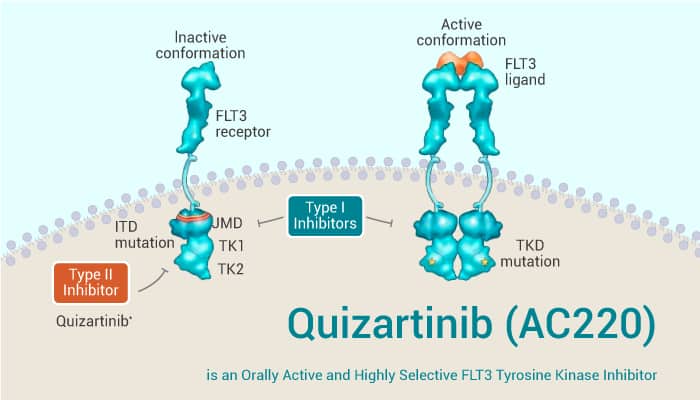Receptor tyrosine kinase FMS like tyrosine kinase 3 (FLT3) is a member of the class III receptor tyrosine kinase family. The family also includes FMS, kit, and platelet-derived growth factor (PDGF) receptors. Specifically, FLT3 is relevant to regulating the survival, proliferation, and differentiation of hematopoietic stem/progenitor cells. The normal expression of FLT3 is in hematopoietic progenitor cells. Besides, abnormal expression of FLT3 is in acute leukemia cells. Both types of FLT3 mutations lead to constitutive activation of FLT3 kinase activity and induce spontaneous proliferation of factor-dependent hematopoietic cell lines.
Moreover, the internal tandem repeat of the FLT3 gene (FLT3-ITD) is one of the most common gene mutations in acute myeloid leukemia (AML). The change of the FLT3 gene will relieve the regulation of the FLT3 downstream signal pathway and increase cell proliferation and survival. Furthermore, targeted inhibition of mutant tyrosine kinase may be an attractive therapeutic strategy for hematological malignancies. Therefore, FLT3 is considered to be a reasonable target for therapeutic intervention against common mutant genes in AML. Here, we will introduce a selective FLT3 tyrosine kinase inhibitor, Quizartinib.
Quizartinib (AC220) is an Orally Active and Highly Selective FLT3 Tyrosine Kinase Inhibitor.

First of all, Quizartinib is a second-generation type II FLT3 tyrosine kinase inhibitor, with a Kd of 1.6 nM. Meanwhile, Quizartinib inhibits wild-type FLT3 and FLT3-ITD autophosphorylation in MV4-11 cells with IC50s of 4.2 and 1.1 nM, respectively. Nonetheless, Quizartinib can be linked to the VHL ligand via an optimized linker to form a PROTAC FLT3 degrader. Quizartinib induces apoptosis.
In the second place, Quizartinib inhibits MV4-11 and A375 cells with IC50 of 0.56 nM and >10 000 nM, respectively. Additionally, Quizartinib inhibits FLT3 with low nanomolar potency in cellular assays. Importantly, Quizartinib is highly selective when screened against the majority of the human protein kinome.
Last but not the least, Quizartinib significantly extends survival in a mouse model of FLT3-ITD AML at doses as low as 1 mg/kg/day by orally. Particularly, Quizartinib eradicates tumors in an FLT3-dependent mouse xenograft model at 10 mg/kg. Obviously, Quizartinib potently inhibits FLT3 activity in primary patient cells. Quantitation of total FLT3 and phospho-FLT3 in tumor samples revealed time-dependent inhibition of FLT3 autophosphorylation.
All in all, Quizartinib (AC220) is an orally active, highly selective FLT3 tyrosine kinase inhibitor.
References:
Zarrinkar PP, et al. Blood, 2009, 114(14), 2984-2992.